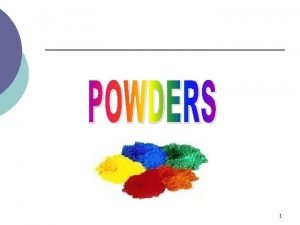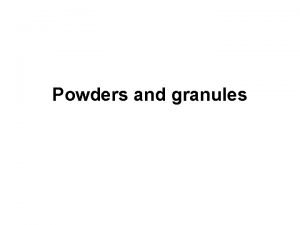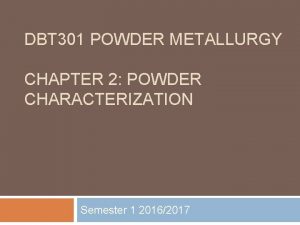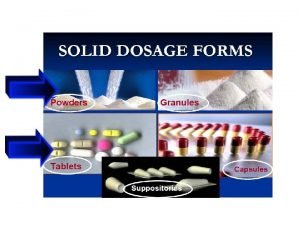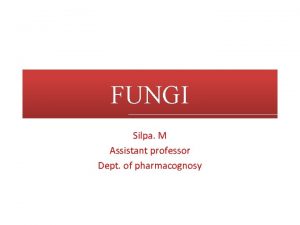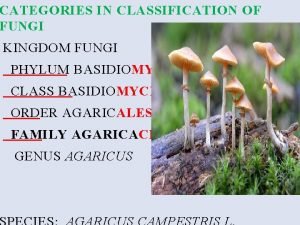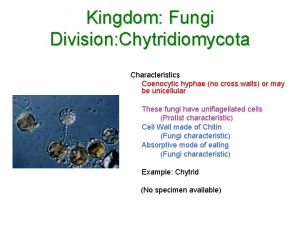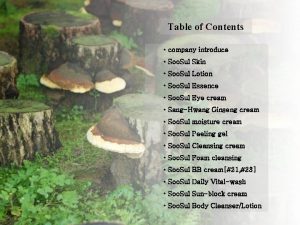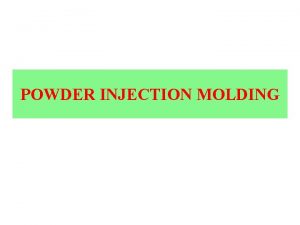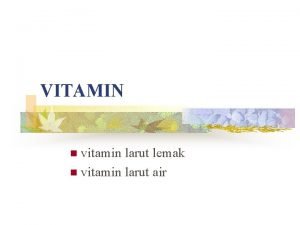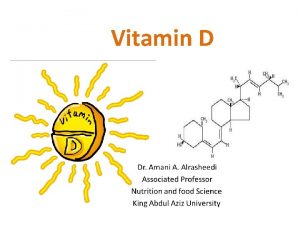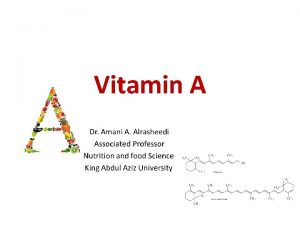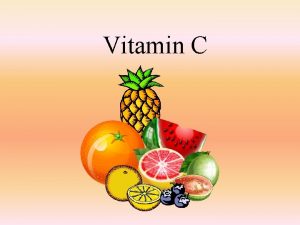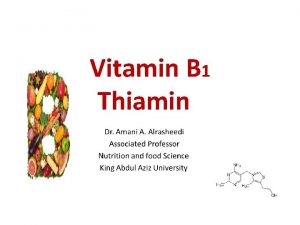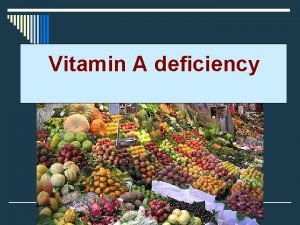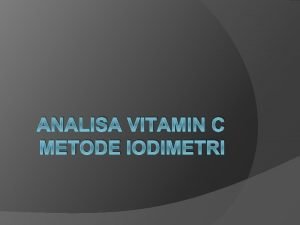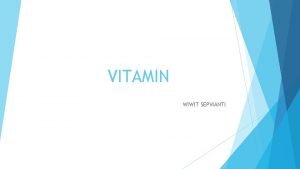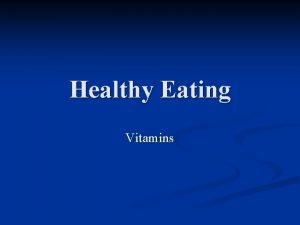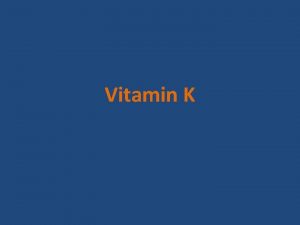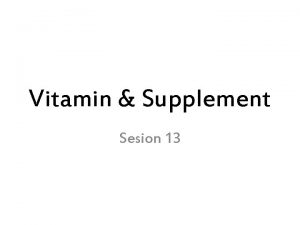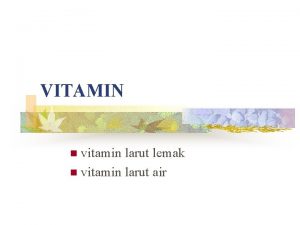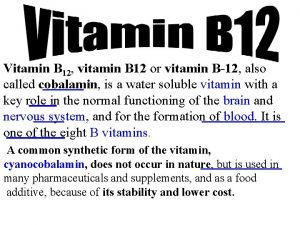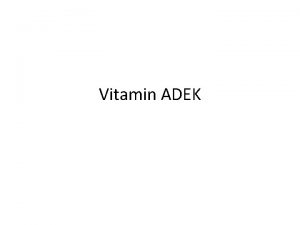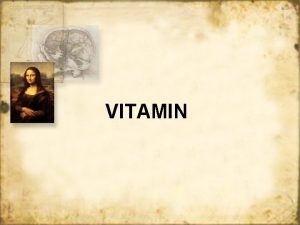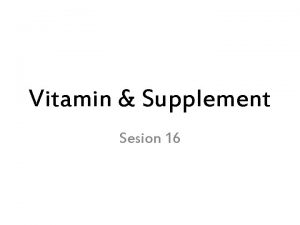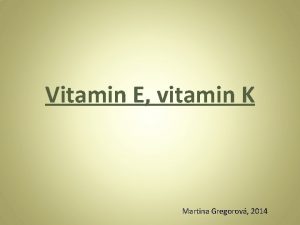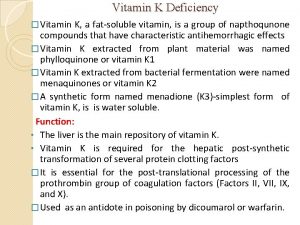High Vitamin D Mushroom Powder June 2020 High




























- Slides: 28

High Vitamin D Mushroom Powder June 2020

High Vitamin D Mushroom Powder Organic Kosher Non-GMO Vegan Plant-based All-Natural Vitamin D 2 Whole Food 100% mushroom, no additives Self-affirmed GRAS Produced in the USA Retains all nutritional components of a mushroom

Outline Monterey High Vitamin D Mushroom Powder Benefits D 2 Mushrooms, Inc of Vitamin D and D 3 are the same Benefits of Mushrooms

Monterey Mushrooms, Inc Largest mushroom grower and supplier in the US Established 1971 – Watsonville, CA 4, 000 employees Annual production > 260 million lbs fresh mushroom/year Three divisions; Mushrooms, Spawn and Nutrition Organic – California Certified Organic Farmers (CCOF) www. montmush. com www. amycel. com


High Vitamin D Mushroom Powder – Method of Production Mushrooms, like humans, have the ability to produce Vitamin D when exposed to sunlight. However, most all commercial mushrooms are grown in-doors in controlled environments with no sunlight exposure. The USDA teamed up with Monterey Mushrooms to produce a light technology that replicates sunlight to naturally increase the Vitamin D 2 levels in mushrooms without affecting the integrity of the mushroom and its nutritional composition. We expose our mushrooms to a specific, low energy, spectrum of UVB light to generate 5, 000 IU/g to 10, 000 IU/g of Vitamin D 2. We only use the highest quality, fruiting body of mushrooms. Vitamin D 2 concentration is verified by 3 rd party laboratory.

Why Vitamin D? ◦ Vitamin D deficiency is a major global public health issue. ◦ About 1 billion people worldwide have vitamin D deficiency, while 50% of the population has vitamin D insufficiency. (Nair et al 2012) ◦ At least 13 internal cancers are associated with D deficiency ◦ Every cell in the human body has Vitamin D receptors

Diseases associated with Vitamin D Deficiency Coronary artery disease Hypertension Diabetes Type I and Type 2 Osteoarthritis Depression Epilepsy Polycystic Ovaries Musculoskeletal Pain Autoimmune Disease Multiple Sclerosis Cancers Falls in the Elderly Alzheimer’s Disease

Heart Disease Risk of having a heart attack doubles with 25(OH)Vit. D levels < 34 ng/ml (Scragg et al. 1990; 19) Congestive Heart Failure patients have much lower 25(OH)Vit. D levels than controls (Zitterman et al. 2003) Deaths from Cardiovascular Disease are more common in winter (Scragg et al. 1981) 1, 739 individuals followed for 5. 4 years: Compared to having a level >15 ng/ml (Wang et al. 2008) : ◦ 25(OH)Vit. D < 10 ng/m. L - 80% greater risk of having a cardiovascular incident ◦ 25(OH)Vit. D = 10 -15 ng/m. L - 53% increased risk ◦ The authors concluded vitamin D deficiency is positively correlated with incident cardiovascular disease.

Hypertension Blood Pressure is: ◦ Higher in winter ◦ Higher with increasing latitude ◦ Higher with darker skin pigmentation Hypertension patients given UV light treatments 3 times per week for 6 weeks had Vitamin D level increases of 162% and saw decreases in BP (Krause et al. 1998) Study with 148 women showed supplementation of Vitamin D (800 iu) with calcium for 8 weeks was more effective in decreasing BP than calcium alone. (Pfeifer et al. 2001)

Vitamin D & Type 1 Diabetes A birth-cohort study with > 10, 000 people ◦ Children followed-up at age 1 year. Supplementation of infants with Vitamin D 2, 000 IU/day decreased incidence of Type 1 Diabetes by 80% (Hypponen et al. 2001). Use of cod liver oil, an important source of dietary Vitamin D, has shown association with significant reduction of incidence of Type I Diabetes, especially in the first year of life (Stene et al. 2003).

Vitamin D and Type 2 Diabetes Low Vitamin D levels associated with insulin resistance and Beta-cell dysfunction 126 healthy glucose-tolerant subjects. Data showed a positive correlation of 25(OH)D concentration with insulin sensitivity. Subjects with hypovitaminosis D are at higher risk of insulin resistance and the metabolic syndrome (Chiu et al. 2004). Trial of 10 women with Type 2 Diabetes; Vitamin D 1, 332 IU/day for 30 days (Borrisova et al. 2003) ◦ 21% increase in insulin sensitivity

Vitamin D and Cancer Vitamin D levels inversely correlated to colon cancer mortality (Freedman et al. 2007) Long-term study of 50, 000 men at Harvard School of Public Health suggests vitamin D may reduce the risk of all cancers by at least 30 percent. (Giovannucci et al 2006) Decreased sunlight associated with increased cancer mortality; Breast, colon, cancer, prostate, bladder, esophagus, kidney, lung, pancreas, rectum, stomach, uterus, non-Hodgkin’s Lymphoma (Grant. Cancer. 2002; 94(6): 1867) 47, 800 men over 14 years – 10 ng/ml rise in Vitamin D levels associated with (Giovanucchi et al. 2006) : ◦ 17% reduction in cancer incidence ◦ 29% reduction in all cancer mortality ◦ 45% reduction in GI cancer mortality

Vitamin D and Inflammation Vitamin D injections averaging 547 iu/day x 2 -5 years – 23% decrease in CRP (Timms et al. 2002) Vitamin D supplementation in patients w/ prolonged clinical illness saw decreases in IL-6 and CRP (Van den Berghe et al. 2003)

Vitamin D and Lactation Breast-feeding mothers need 4, 000 IU of vitamin D a day in order to maintain adequate infant Vitamin D status. 2, 000 IU/day was not as effective. Wagner et al. 2003 Hollis et al. 2004 Basile et al. 2006 25 -OH-D content of maternal milk responsible for vitamin D concentrations of serum of exclusively breastfed infants Cancela et al. 1986

Vitamin D and Depression Seasonal Affective Disorder is prevalent when Vitamin D stores are typically low. ◦ 15 subjects with SAD given either single dose 100, 000 IU Vitamin D or light therapy for one month. Depression significantly decreased in those given Vitamin D versus those who received light therapy. (Gloth et al. 1999) 44 subjects given either 400 IU, 800 IU, or 0 IU of Vitamin D per day, Vitamin D associated with significantly improved mood within 5 days (Landsdowne et al. 1998)

Vitamin D and Falls in the Elderly Vitamin D receptors in skeletal muscle Bischoff HA, et al. Histochem J 2001; 33: 19. Vitamin D deficiency reported to affect predominantly the weight-bearing antigravity muscles of the lower limb, which are necessary for postural balance and walking Glerup H et al. Calcif Tissue Int 2000; 66: 419. Vitamin D supplementation appears to reduce the risk of falls among older individuals with stable health by more than 20% Bischoff-Ferrari et al. 2004 DOI: 10. 1001/jama. 291. 16. 1999

Vitamin D and Pain Study with 150 patients with persistent, nonspecific musculoskeletal pain at Mayo clinic; 93% had Vitamin D deficiency Plotnikoff, Quigley. Mayo Clin Proc. 2003; 78(12): 1463. Lower Back Pain ◦ 83% of 299 Lower back pain patients with no obvious cause found to have Vitamin D deficiency ◦ After treatment of 5000 -10, 000 iu/day, clinical improvement in all groups that had low Vitamin D, and in 95% of all patients was reported after 3 months. Al Faraj, Al Mutairi. Spine 2003; 28(2): 177.

Vitamin D and Immune Health Vitamin D receptors are expressed on all immune cells. The active form of Vitamin D is called calcitriol (1, 25(OH)2 D), can act as an immune system modulator. Deficiency in vitamin D is associated with increased autoimmunity as well as increased susceptibility to infections. (Aranow 2011) Calcitriol prevents excessive expression of inflammatory cytokines and increases the ‘oxidative burst’ potential of macrophages to kill bacteria. Calcitriol dramatically stimulates the expression of potent antimicrobial peptides, which exist in neutrophils, monocytes, natural killer cells, and in the epithelial cells that line the respiratory tract where they play a major role in protecting the lung from infection. Cannell et al. 2006

Vitamin D and Immune Health ◦ UVB radiation and cod liver oil (high in Vitamin D) reduce the incidence of viral respiratory infections. (Cannell et al. 2006) ◦ Epidemiologic studies demonstrated associations between seasonal variations in Vitamin D concentrations and incidence of various infectious disorders. Epidemic influenza and vitamin D – (Cannell et al. 2006) Association between serum 25 -hydroxyvitamin D level and upper respiratory tract infection in the Third National Health and Nutrition Examination Survey – (Ginde 2009) Observational studies (n = 25) report broadly consistent inverse associations between vitamin D status/intake and risk of acute respiratory infection – (Jolliffe 2013)

Forms of Vitamin D

Vitamin D Metabolism John Cannell and Bruce Hollis, Alternative Medicine Review Volume 13, Number 1 March 2008

Why Vitamin D 2? As of 2018, 9. 8 Million in the US called themselves “Vegan” (3%), 16 million called themselves “Vegetarian” (5%) – Gallup poll 2018 Vitamin wool. D 2 D 3 is synthesized from oil from sheep’s is Vegan; D 3 is neither Vegan or vegetarian

Vitamin D 2 vs. D 3 34 healthy adults, from a placebo-controlled, double-blind study, who received either a placebo, 1000 IU Vitamin D 3, or 1000 IU of Vitamin D 2 daily for 11 weeks showed that Vitamin D 2 and Vitamin D 3 induced similar increases in total 25(OH)D as well as in 25 -hydroxyvitamin D 2 and 25 hydroxyvitamin D 3 respectively. (Holick et al. 2013) 68 subjects randomly assigned, double-blind; Placebo, 1000 IU D 2, 1000 IU D 3, or 500 IU D 2 + 500 IU D 3 taken daily for 11 weeks. A 1000 IU dose of Vit. D 2 was as effective as 1000 IU dose of Vit. D 3 in maintaining serum 25(OH)D levels and did not negatively influence serum 25(OH)D 3 levels. (Holick et al. 2008)

Why Mushrooms? Mushrooms are strong antioxidants > seven (7) published papers Mushrooms are anti-inflammatory > three (3) published papers Mushrooms strengthen the immune system > two (2) published papers Mushrooms help you eat less and lose weight > two (2) published papers Mushrooms help you maintain healthy cholesterol levels > three (3) published papers Mushrooms demonstrate anti-tumor and anti-cancer activity > sixteen (16) published papers

Why Mushrooms? Global consumption of mushrooms is 3. 3 million metric tons ◦ ◦ ◦ ◦ All others: 10% Canada: 3% China: 38% EU: 31% Japan: 2% Russia: 2% US: 14% (1. 7 kgs/person)

Marketing Position VEGAN WHOLE FOOD NATURAL GOOD SOURCE OF VITAMIN D AND MUSHROOMS RAISES SERUM LEVELS OF 25 HYDROXYVITAMIN D IMPROVES IMMUNE HEALTH MUSHROOMS CONTAIN MANY ANTIOXIDANTS MUSHROOMS CONTAIN ANTI-CANCER/ANTI-TUMOR COMPOUNDS MUSHROOMS HAVE ANTI-INFLAMMATORY PROPERTIES EATING MUSHROOMS PROMOTES SATIETY/HEALTHY WEIGHT

THANK YOU! Guzen Development sales@guzendevelopment. com 925 -938 -2724
 Vitamin d mushroom powder
Vitamin d mushroom powder Finely divided, bulk effervescent
Finely divided, bulk effervescent Powder dosage form example
Powder dosage form example Powder characterization in powder metallurgy
Powder characterization in powder metallurgy Finely divided bulk effervescent dusting dental all type of
Finely divided bulk effervescent dusting dental all type of New irpwm june 2020
New irpwm june 2020 Www.inf
Www.inf Mushroom theory of management
Mushroom theory of management Dimorphic fungi mean
Dimorphic fungi mean A mushroom and a humpback whale are alike
A mushroom and a humpback whale are alike Fungi phylum
Fungi phylum Mushroom keratoplasty
Mushroom keratoplasty Aspergillus
Aspergillus Division of kingdom fungi
Division of kingdom fungi A mushroom and a humpback whale are alike because both are
A mushroom and a humpback whale are alike because both are Tom is a mushroom farmer he invests
Tom is a mushroom farmer he invests Mushroom countable or uncountable
Mushroom countable or uncountable Invasive mushroom species
Invasive mushroom species American mushroom institute
American mushroom institute Sulskin
Sulskin Mushroom culture technology
Mushroom culture technology Mushroom taxonomy classification
Mushroom taxonomy classification Are fungi multicellular or unicellular
Are fungi multicellular or unicellular A metal can containing condensed mushroom soup
A metal can containing condensed mushroom soup Stuy arista
Stuy arista Clements high school courses
Clements high school courses Ice hockey ppt
Ice hockey ppt Solanco powerschool
Solanco powerschool Psja high school lunch menu
Psja high school lunch menu

